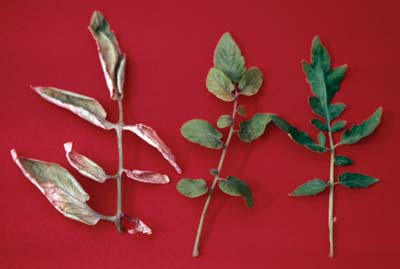To save the Web-optimized images shown below to your hard drive:
|
Click to access Display and Print quality images. |
Host plants are primarily in the family Solanaceae (tomato and its relatives). The tomato russet mite is a primary pest on tomato but also affects eggplant, pepper, potato, and tomatillo. Weeds that serve as alternate hosts include gooseberry, black nightshade, jimson weed, hairy nightshade, small-flowered nightshade, and silverleaf nightshade. Mites injure the plant by puncturing surface cells and sucking out cell contents. Infested plants will have a bronzed or russeted appearance on both the stems and leaves. Leaves may also curl, become dry, and drop from the plant. Fruit and blossoms may also be infested and some fruit may become scalded by the sun after leaf drop occurs.
Mites are readily spread by the wind. Scouting can be difficult because mites are barely visible without magnification. Growers should monitor for damage and confirm mite presence microscopically. Cultural management practices include sanitation, early planting, resistant cultivars, and removal of alternate hosts. Insecticides and acaricides are available. Insecticidal soaps, oils, or elemental sulfur may be used to manage mite populations. Natural enemies, such as predatory mites, should be taken into account before acaricides are applied.
Images
To save the Web-optimized images shown below to your hard drive:

Tomato russet mite damage to tomato with an undamaged
leaf for comparison.
(Photographer: D. Schuster, University of Florida)
Click to access Display and Print quality images.
|
Click to access Display and Print quality images. |